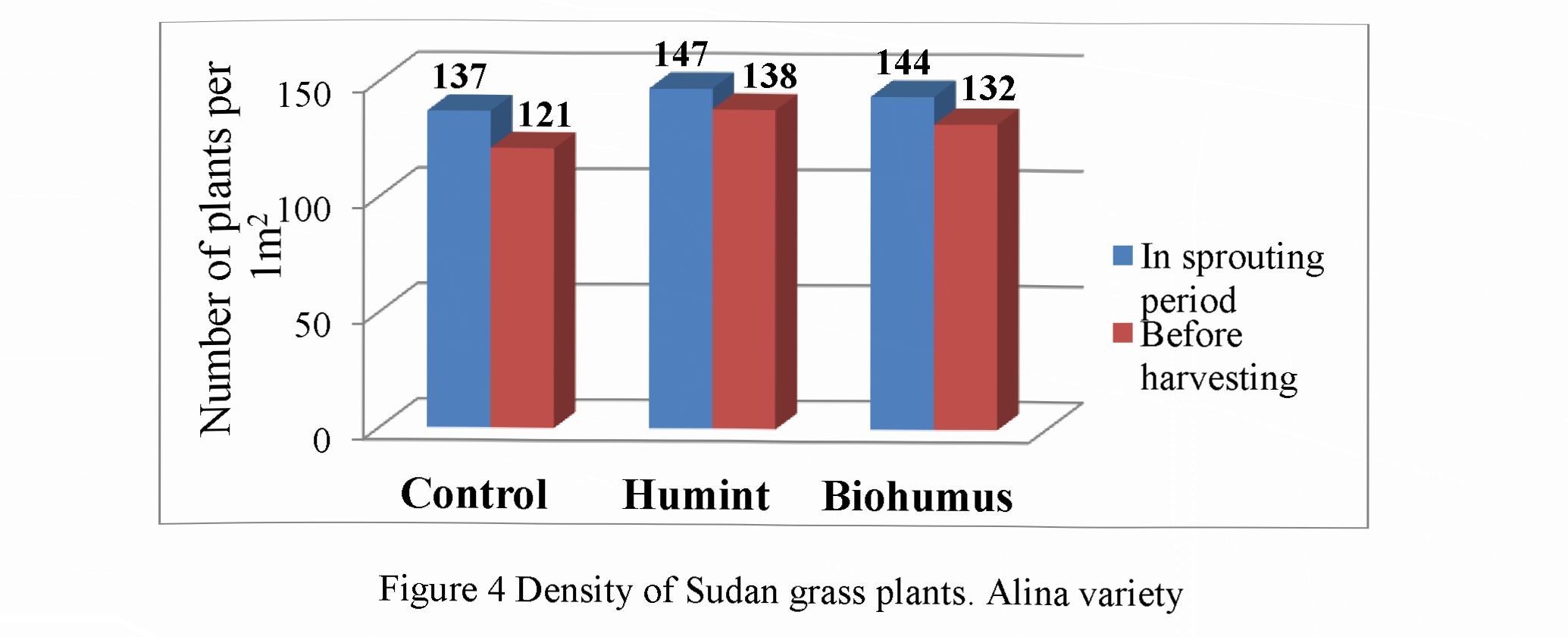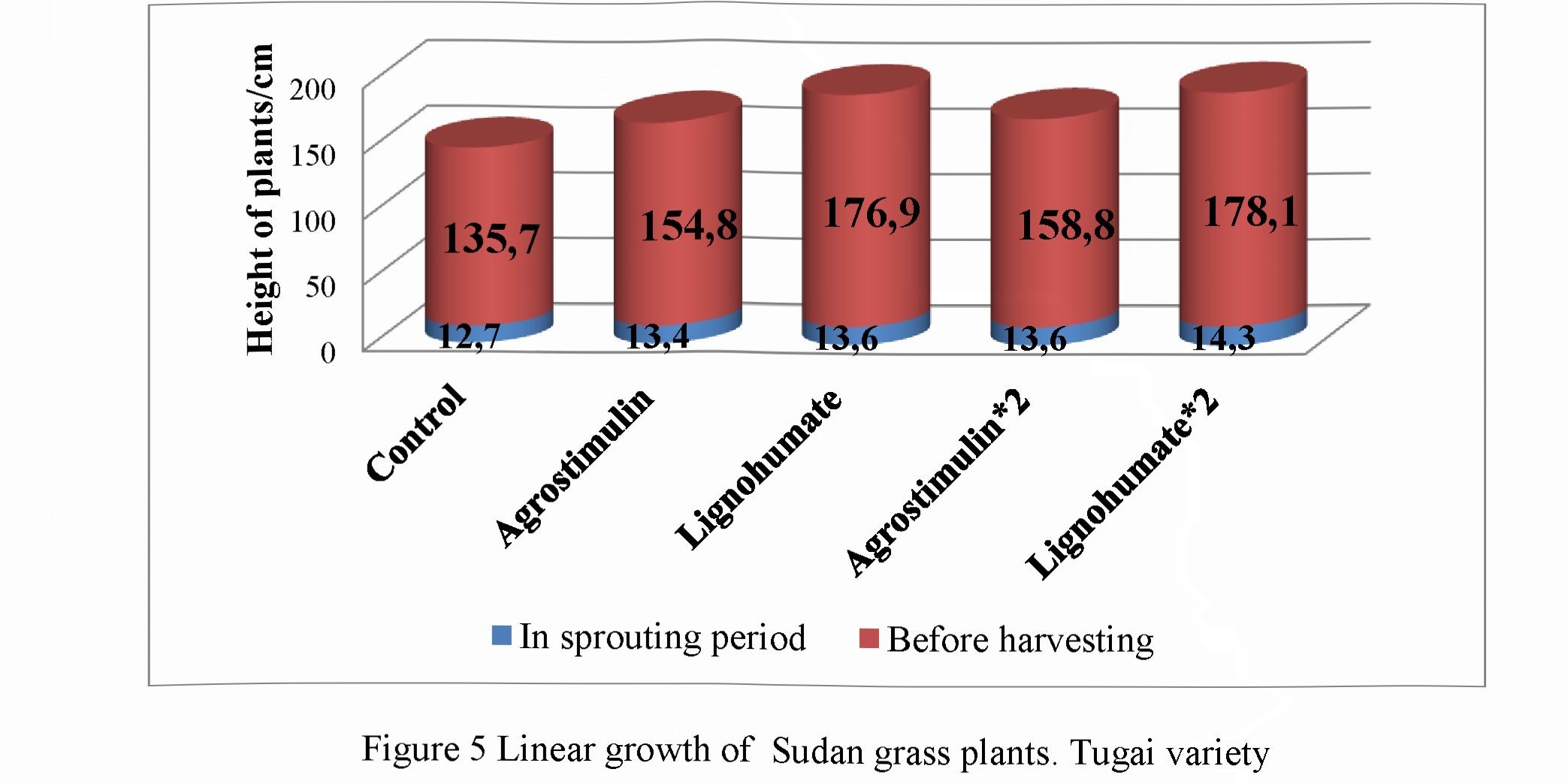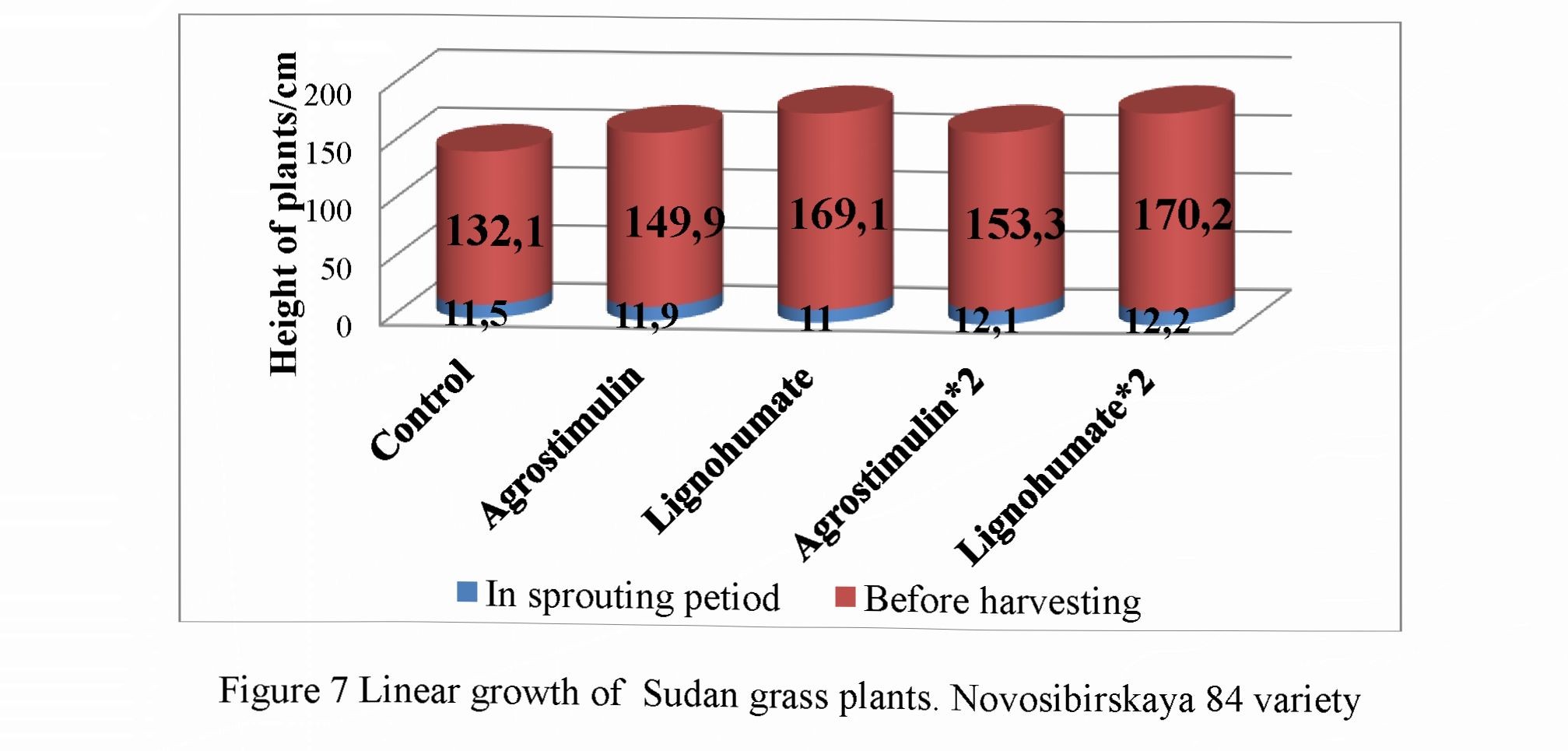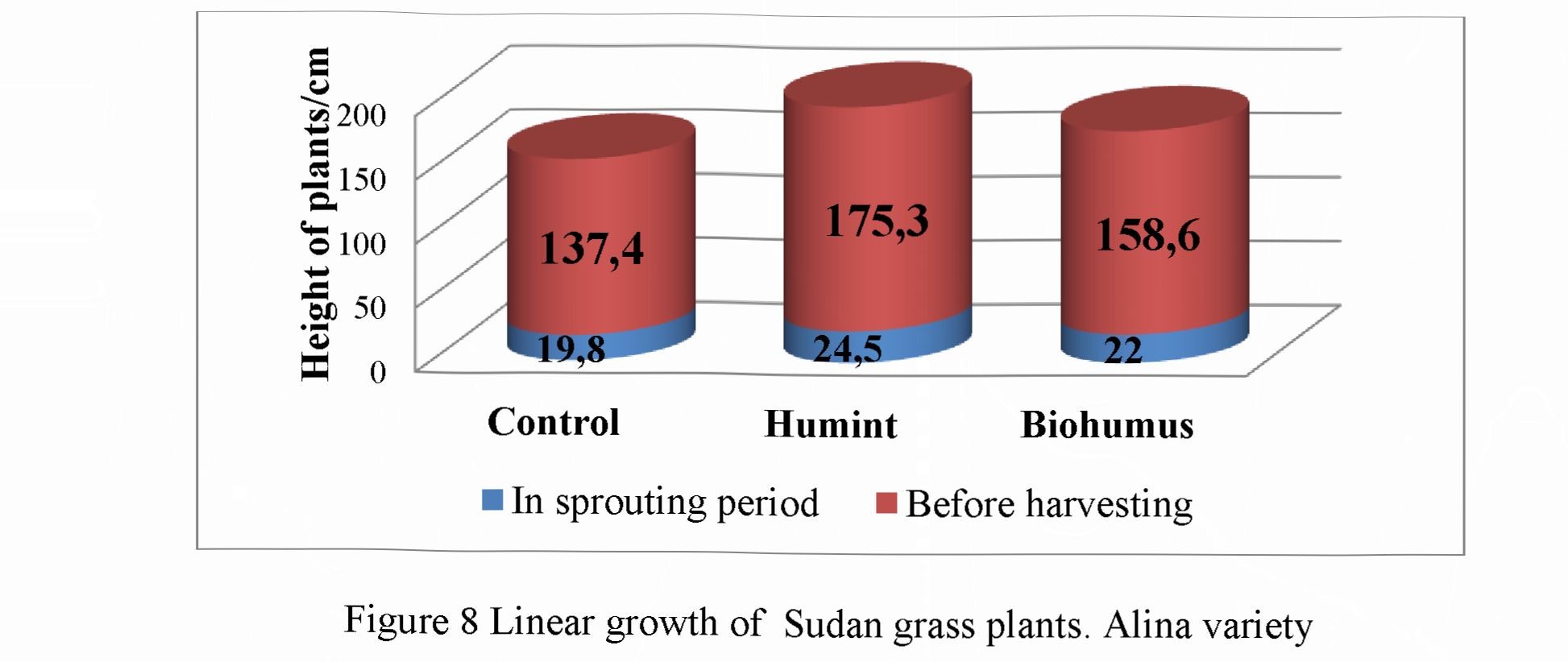Annotation
The article contains results on the theme of the scientific research "Efficiency of the use of growth stimulant and microfertilizer in the cultivation of the Sudan grass (Sorghum sudanense L.) on seeds in the conditions of North Kazakhstan region" are presented.
The research work shown comparison between fertilizers that used to study their influence to different A arities of Sudan grass. Objects of investigation: Biohumus, Humint, Agrostimulin, Lignohumate fertilizers and plants of Sudan grass (Sorghum sudanense L.).
Used fertilizers previously were not used in Kazakhstan for the cultivation of Sudan grass (Sorghum sudanense L.). The work include the results that were observed during the whole vegetation period of this culture. Work consist of data the density of the standing, and linear growth of the Sudan grass (Sorghum sudanense L.). Certain conclusions and recommendations were made. The results of the use of organic fertilizers for Sudan grass (Sorghum sudanense L.) in the Northern Kazakhstan conditions can be useful for fanners and other agrarians of the North Kazaklistan region, Kazaklistan and the world as a whole.
Introduction
In Kazakhstan, the region of Northern Kazakhstan in particular, is the task of developing meat cattle breeding. For the intensive development of livestock and its intensification, cheap, high - grade, high - nutrition fodders has neccesity in sufficient quantities. Feed crop give for animals green food, hay, haylage, silage, dehydrated and fortified food [1].
They are can provide animals with cheap, high-grade fodders, balanced for protein, energy, amino acids, especially in their green mass in modern conditions [2].
The conditions of farming and fodder production in Northern Kazakhstan are extremely diverse. Common to all zones is the continentality of the climate, characterized by a general lack of heat, a short vegetation period, late spring and early spring frosts, a moisture deficit, and the variability of meteorological factors by years [3].
One of the forage crops, the most valuable and promising for cultivation in the conditions of Northern Kazakhstan is the Sudan grass (Sorghum sudanense L.). Sorghum belongs to the tribe Andropogoneae of the Gramineae family Poaceae [4].
Sudan grass is a valuable crop for the production of green forage, hay and silage. Green mass both on the pasture and in the sloping form is well eaten by all kinds of cattle [5]
Sudan grass (Sorghum sudanense L.) is favorably different from other forage grasses in that it produces high - yielding hay. Its chemical composition characterized by the following indexes: protein 16%, fiber 28%, fat 2.9%, nitrogen-free extractives 43%, sugars 3 - 8% [6].
The protein content decreases sharply at the beginning of the earing - flowering, but the content of cellulose increases markedly. According to the content of fat and nitrogen - free extractives, it almost does not differ from the hay of annual grasses and leguminous grasses. Sudan grass contain tannins and phytic acid there are less digestible than other cereals for human and monogastric animals [7].
The most valuable economic quality of Sudan grass is high ability to grow after mowing or proper bleeding. Under favorable conditions, its growth during the day can reach to 5 - 10 cm [8].
In the experiment were used organic fertilizers that previously applicate to cultivate Sudan grass.
Gumint - ecologically safe bioorganohumine fertilizers with water-retaining and growth - stimulating activity. This fertilizer is produced by LLP "Scientific and Production Complex" Intellect "in Karaganda. The main components for the preparation of bioorganic fertilizers are livestock waste (manure, chicken litter), crop production and humic substances of coal waste [9].
Biohumus is an environmentally pure organic fertilizer, a product of processing cattle manure by a population of a technological worm. This concentrated fertilizer contains in a balanced combination a whole complex of necessary nutrients and trace elements, enzymes, soil antibiotics, vitamins, growth hormones and plant development. It has a large amount of humic acids [10].
Lignohumate - research and Production Enterprise «Implementation of ecological technologies» (AET, Ltd RET) developed large-scale production of humic products under the trade name «Lignohumates», using Iigninsulfonates as organic raw material. Lignohumate is produced in a controlled process of Iignosulphonate desruction followed by secondary synthesis of organic matter.
Agrostimulin» promotes the accelerated division of plant cells, the development of a more powerful root system, an increase in the leaf area and chlorophyll content, reduces the phytotoxic effect of pesticides, has an antimutagenic effect, improves the quality of the grown produce, improves yield, plant resistance to diseases, stress factors, resistance to adverse factors of the external environment (overcooling, overheating, lack or excess of light and moisture), it becomes possible to reduce the rates introduced pesticides, 3-5 times during the growing season when using the drug.
Material and methods
The research work was conducted from of June 2015 to September 2017.
The experimental part of the study on the effectiveness of fertilizers was carried out in limited partnership North - Kazakhstan Research Institute of Plant Growing and Livestock on the sowing of Sudan grass.
The main method of study is the field experiment, that studying various issues of farming: crop rotations, soil tillage, fertilizer application, planting and care for plants, and in variety testing and testing of machines [11].
For the experiment, were performed 2 field experiments, where for 1 experiment in 4 - fold replicas and 5 variants on a plot of 25 - 45 m2 in 2015 and 2 experiment in 4-fold replicas and 3 variants for cultivating Sudan grass seeds on a plot of 2-5 m2 in 2017 [12].
The sowing of Sudan grass took place on the 4 of June in 2015 and on the 2 of June in 2017. The norm of sowing the Sudan grass was 10 kg / ha. Seeding depth 2-3 cm.
To conduct research the study of the efficiency of fertilizer application on plants of Sudan grass, selected Sudan grass varieties. For the implementation of the experiment, four varieties were taken: Tugai, Novosibirskaya 84, Kinelskaya 100, Alina.
The objects of the study plants of Sudan grass and Humint, Biohumus, Lignohumate, Agrostimulin fertilizers. The rate of Humint fertilizer consumption 7-8 kg / 100 m2.The rate of Biohumus fertilizer consumption - It / ha. The rate of Agrostimulin application for seed treatment is 20-25 ml / t, for spraying crops - 10-15 ml / ha. Average consumption of Lignohumate per 1 ton of seeds was 0,5-0,75 liters liquid modifications.
Results and discussion
In order to determine the effectiveness of the application of organic fertilizers in the cultivation of Sudan grass for seeds under the conditions of Northern Kazakhstan was used the field experiment. For experiment implementation we had 3 variants, one of them was a control one, in which there was no processing, all Subsequentoneshadan experimental setting. The research work consist of the several stages. The first sta«e included the phenological observations during the winter period in 2015 and 2017
After we started to determine the efficiency of fertilizers affecting to the growth and development of Sudan grass, were considered the indicators of the density of standing, linear growth, structure, yield of plants.
In research work were identified the influence of the growth stimulant and microfertilizer to Sudan grass plants on the example of 3 varieties and 5 variants in 2015, and the effect of fertilizers on Sudan grass plants on example 1 variety and 3 variants in 2017’
In this article, made a comparison between the indicators of density of standing and linear growth when studying the effectiveness of fertilizer application between different varieties of Sudan grass.
The first indicator was determined - the density of standing of plants of Sudan grass, during in the period of the sproutings and before harvesting. In the Tugai variety, the number of plants on the control in the sprouting period was 139, before harvesting the number of plants decreased by 9 and amounted to 130 plants. In variants using fertilizers Agrostimulin and Lignohumate, the number of plants per m2 increased by 143 and 146, respectively, which was 4 and 7 in comparison with the control, and the number of plants before harvesting was 135 and 141, respectively. In the variants with the use of double treatment with fertilizers Agrostimulin and Lignohumate, the number of plants was 145 and 147, respectively, which was 6 and 8 more than in the control version. Fewer of non-surviving plants was observed in version 5 with a double treatment of Lignohumate, only 4 plants, and on control the number of non-surviving plants was 9.
The value of the density in the variant with using Agrostimulin double treatment reflects a smaller number of plants and a greater loss of plants before harvesting than in variant 3 with using Lignohumate. With the application of Lignohumate number of non-surviving plants was 5 plants, with double treatment with Agrostimulin - 7. When plants was processed with Lignohumate double treatment, the values of density was the highest compared to the control.
Thus, a comparison of all the variants with each other showed that the double processing of Sudan grass plants does not give always high density indices, as in the example by double treatment with Agrostimulin. Presowing treatment with Lignohumate was sufficient to obtain the density necessary for a good harvest. This fact was reflected in the following variants of Sudan grass.
 In the Kinelskaya IOO variety of Sudan grass, was observed a similar dynamics of density in the variants. Comparing the variants with double treatment with Agrostimulin and a variant with presowing seed treatment with Lignohumate, showed the advantage of Lignohumate confirming its effectiveness. The use of double processing did not contribute to an increase in density per 1 m2. The density of plants for both variants with the use of Agrostimulin was 143 plants, but in the variant with double treatment of Agrostimulin more plants were retained and the loss of plants was equal to 8 plants than in the one treatment variant with using Lignohumate, where the loss of plants was 11 plants.
In the Kinelskaya IOO variety of Sudan grass, was observed a similar dynamics of density in the variants. Comparing the variants with double treatment with Agrostimulin and a variant with presowing seed treatment with Lignohumate, showed the advantage of Lignohumate confirming its effectiveness. The use of double processing did not contribute to an increase in density per 1 m2. The density of plants for both variants with the use of Agrostimulin was 143 plants, but in the variant with double treatment of Agrostimulin more plants were retained and the loss of plants was equal to 8 plants than in the one treatment variant with using Lignohumate, where the loss of plants was 11 plants.

Figure 2 Density of Sudan grass plants. Kinelskaya 100 variety
The Novosibirskaya 84 variety showed that on the control and variant with application of presowing treatment with Agrostimulin the loss of plants was the highest and amounted to 12 pcs. In the variant, using the double treatment with Lignohumate, plant mortality was only 5 plants. Almost the same densities in the variants in the application of presowing seed treatment with Lignohumate and in the variant with double treatment Agrostimulin - 144 and 143 plants respectively, the loss of plants was 7 and 9 plants respectively.

Figure 3 Density of Sudan grass plants. Novosibirskaya 84 variety
The Alina variety was a significant increase in the number of plants per m2 in the variants where Humint fertilizer was used and was 147, which was more to 10 plants than on the control. In the variant with the use of Biohumus the density was 144, which was to 7 plants more than on the control. Large loss of plants was observed on the control and amounted to 16 plants. In the variant with the use of Humint, the loss of plants was 9 plants, and in the variant with the use ot Biohumus 12 plants. Analyzing the number of plants that did not survive to the period before harvesting, in all variants was much, even in variants with application ot fertilizers. On control, the number of loss plants was 16 plants, this fact was explained by long rains before sowing crops in the last decade of May 2017 and lack of heat during the growing season.
Thus, the determination ot the density of plants according to varieties and variants has shown that the application of fertilizer increases the number of plants per 1 m2 to 10 plants using Humint. And also there was a positive dynamics of density with the use of microfertilizer Lignohumate, where even one preseeding treatment was sufficient to increase the number of plants per 1 m“ to 8 plants in the varieties Kinelskaya 100 and Novosibirskaya 84.
Presowing treatment of plants with Lignohumate and double treatment with Agrostimulin showed practically the same densities in Tugai and Kinelskaia varieties 100 - 146 and 145 and 144 and 143, respectively.
In the Kinelskaya 100 variety, the application of presowing seed treatment and double treatment with Agrostimulin showed no increase in density and was identical in the two variants equal to 143 plants.
The Tugai variety had a large number of non - surviving plants before harvesting to 16 plants, which was due to unfavorable conditions before sowing the crop.
After determining the density of plants in the sowing period and before harvesting, followed a calculation ot the safety of plants, i.e. the number of plants that survived until harvest.
The next indicator in the study of the efficiency of fertilizers was the linear growth of plants, which was measured twice: in sprouting period and before harvesting.
 In the Tugai variety, in sprouting period, the height of the plants was 12,7 cm. In the variants with the use of the presowing treatment by Lignohumate and double treatment by Agrostimulin, the plant height showed the same linear growth 13,6 cm, which indicates the identical effect of the presowing treatment by Lignohumate and double treatment by Agrostimulin. Double processing with fertilizer Lignohumate showed the best result of plant height and was 14,3 cm. Presowing treatment by Lignohumate and double treatment with fertilizer Lignohumate showed a high height before harvesting and amounted to 176,9 cm and 178,1 cm, respectively, which was 41,2 cm and 42,4 cm higher than the control. The height on the control was 135,7 cm. The treatment ot plants with Agrostimulin increased the height by 19,1 and 23,1 cm in comparison with the control, but much inferior to the heights where Lignohumate was used.
In the Tugai variety, in sprouting period, the height of the plants was 12,7 cm. In the variants with the use of the presowing treatment by Lignohumate and double treatment by Agrostimulin, the plant height showed the same linear growth 13,6 cm, which indicates the identical effect of the presowing treatment by Lignohumate and double treatment by Agrostimulin. Double processing with fertilizer Lignohumate showed the best result of plant height and was 14,3 cm. Presowing treatment by Lignohumate and double treatment with fertilizer Lignohumate showed a high height before harvesting and amounted to 176,9 cm and 178,1 cm, respectively, which was 41,2 cm and 42,4 cm higher than the control. The height on the control was 135,7 cm. The treatment ot plants with Agrostimulin increased the height by 19,1 and 23,1 cm in comparison with the control, but much inferior to the heights where Lignohumate was used.
The height of plants of the Kinelskaya 100 variety in the sprouting period was less than 1,1 cm in comparison with the Tugai variety and was 11,6 cm on the control. In the variant with the presowing treatment Agrostimulin, the height was 11,9 cm. And in the variant with the presowing treatment Lignohumate height was 11 cm, lower than on the control by 0,6 cm. In the variants using double processing, the height was 12,2 cm and 12,6 cm. Thus, the height in variants with double treatment increased by 1 cm, which was not significant result.
The height of the plants before harvesting in the Kinelskaya 100 on the control was also lower than in the Tugai. Thus, the height of plants was 133,2 cm. The application of presowing treatment and double treatment by Agrostimulin increased the height of plants by 152 cm and 154,2 cm, respectively. The height of the plants in variants with application of presowing treatment and double treatment with Lignohumate was practically the same and amounted to 171 cm and 171,6 cm.



The linear growth of plants in the Novosibirskaya 84 variety in sprouting period was practically the same. On the control the height of the plants was 11,5 cm, and in the Kinelskaya 100 variant, the height on the control was 11,6 cm. In the variant with the presowing treatment by Agrostimulin and Lignohumate plant height was identical to the height of the Kinelskaya 100 plants and was 11,9 cm and 11 cm respectively. Almost the same altitude was in Novosibirskaya 84 and Kinelskaya 100 in variants with double treatment by Agrostimulin and Lignohumate and amounted to 12,1 cm and 12,2 cm, whereas in the Kinelskaya plant height in these variants was 12,2 and 12,6 cm.
Analyzing the linear growth of plants before harvesting the Novosibirskaya 84 variety, were observed that heights were lower than of Tugai and Kinelskaya 100. The height on the control was 132,1 cm, by 3,6 cm lower than in the Tugai and by 1,1 cm lower than the control in the Kinelskaya 100 variety. In the variant with the application of the presowing treatment by Agrostimulin, the height was 149,9 cm, and with double treatment by Agrostimulin, the height was 153,3 cm. In the variants with presowing treatment by Lignohumate and double treatment by Lignohumate heights was practically identical and was 169,9 cm and 170,2 cm, where the height difference was small and equal to 0,3 cm.
Analyzing the height of plants of the Alina variety in sprouting period observed a big difference in comparison with the other varieties of Sudan grass used in the experiment. In sprouting, the height of the plants on the control was 19,8 cm, which was higher than the Tugai plant by 7,1 cm, which showed the best results. In the variant with the use of Humint, the altitude was 24,5 cm, which was higher than the plants of the variant with the best Tugai variant by 10,2 cm. And in the variant with the use of Biohumus, the altitude was 22 cm, which was higher by 7,7 cm of plants of the Tugai variety. Comparing with other varieties, the Alina variety showed the best results of plant height during the sprouting period, despite the unfavorable conditions during planting.
Despite the fact that the height of plants in the sprouting season in the Alina variety was much higher than in other varieties, the linear growth before harvesting showed similar results as other varieties. So, on the control the height of the plants was 137,4 cm by 1,7 cm higher than the plants of the Tugai variety. In the variant with using Humint, the height of the plants was 175,3 cm, by 1,6 cm lower than the plants of the Tugai variety in the variant with the presowing treatment OfLignohumate. And in the variant with the use of Biohumus, the height was 158,6 cm, which coincides with the indicators of the Tugai variety with a double treatment with Agrostimulin 158,8 cm.

Thus, analysis of plant heights in all varieties in sprouting period showed that the application presowing treatment by Lignohumate and double treatment by Lignohumate testifies the same ettect to plant height. This fact was manifested in the Tugai variety, where the altitude in these cases was 13,6 cm. A high height before harvesting was observed in the Tugai variety in variant with using double processing by Lignohumate 178,1 cm. When analyzing the height ot plants of the Alina variety during the sprouting season, was observed the highest linear growth in comparison with other varieties. Even at the control of the Alina variety, the height ot the plants was 19,8 cm, which was higher by 7,1 cm compared to the control in the Tugai variety. But the height of the plants in the Alina variety before harvesting did not exceed expectations of the highest growth in comparison with other varieties, and showed similar results. Thus, the height on the control was 137,4 cm, by 1,7 cm higher than the plants of the Tugai variety, in the variant with Humint 175,3 cm by 1,6 cm lower than the plants of the Tugai variety in the variant with the presowing treatment by Lignohumate. And in the variant with the use of Biohumus, the height was 158,6 cm, which coincides with the indicators of the Tugai variety with a double treatment with Agrostimulin 158,8 cm.
Conclusion
- Determination of plant density according to varieties and variants showed that application of fertilizers increases the number of plants per 1 m2 to 10 plants using Humint. And also there was a positive dynamics of density with the use of microfertilizer Lignohumate, where even one preseeding treatment was sufficient to increase the number of plants per 1 m“ to 8 plants in the varieties Kinelskaya IOO and Novosibirskaya 84.
- Presowing treatment of plants Lignohumate and double treatment with Agrostimulin showed practically the same densities in Tugay and Kinelskaya varieties IOO - 146 and 145 and 144 and 143 respectively, which indicates the same effect on plants.
- In the Kinelskaya IOO variety, the application of presowing seed treatment and double treatment with Agrostimulin showed no increase in density and was identical in the two variants of 143 plants.
Literature:
- Abdelseed B.H., Abdelwaliab H.A., Abu ElGasim A.Y., Isam A.M.. Babiker E.E. 2011. Some nutritional attributes of selected newly developed lines of sorghum after fermentation. InJoumal of Agricultural Science and Technology. 13. 399 - 409.
- Aluned Suha 0.. Adel Wahab H. Abdalla, TomoeInoue, Aim Ping. Elfadil E.Babiker 2014. Nutritional quality of grains of sorghum cultivar grown under different levels of micronutrients fertilization. In: Food chemistry, 159, 374 - 380.
- Chen К.Н., Huber J.T., Simas J., Theurer С.В., Chan P.Yu, S.C., 1995. Effect of enzyme treatment or steam flaking of sorghum grain on lactation and digestion in dairy cows. Journal of Dairy Science, 78, 1721 - 1727.
- Duncan R.R.1996 Breeding and Improvement of Forage Sorghums for the Tropics. In: Advances in Agronomy. 57. 161 - 185.
- Edwards C.A., Arancon N.Q., Sherman R.L. 2011. Vermiculture technology: earthworms, organic wastes, and environmental management. Ed: Clive A. Edvards et al.CRS Press Taylor and Francis Group Boca Raton London New York, Pages 1-5.
- Elbashir H.Z., Mustafa A.I., El Tinay A.H.. Babiker E.E., 2008. Biochemical characteristics of sorghum (Sorghum bicolor L. Moench) flour supplemented with cluster bean (Cyamopsis Ietragonolaba L.): Influence of fermentation and/or cooking Journal OfBiological Sciences, 8, 722- 729.
- Fazylov S.D.. Abdykalykov M.A., Yushchenko N., Iskakov A.R. 20MJnfluence of composite Organomineral fertilizer on yield of potato and spring wheat” News of the National academy of sciences of the Republic OfKazakhstan, series of agricultural sciences, 5 (23), 68-73.
- Poloskin R.B.. Gladkov O.A.,Osipova O.A.. Yakimenko O.S., 2013. Comparable evaluation of biological activity of new Iiguid and dry modifications of the humic product Lignohumate. In Functions of natural organic matter in changing environment, ed. J. Xu et al. vol 2, 1095-1099, Zhejiang University' Press and Springer Science+Business Media Dordrecht.
- Yakimenko O, Gladkov 0.. Poloskin R., 2008. Chemical and plant growth stimulatory properties of Lignohumate. In From molecular understanding to innovative applications of humic substances, eds, Penninova I.V.. Kulikova N.A., vol 2, 725-727. Moscow-St Petersburg, Russia.
- Минжасов К.И.. Мешетич B.H., Ракицкий И. А. и др. Рекомендации по ведению кормопроизводства на Севере Казахстана // ТОО «Северо-Казахстанский НИИ животноводства и растениеводства». - а. Бесколь, 2011. - С. 59-63.
- Доспехов Б.А. Методика полевого опыта. - M.: ВНИИК. 1985. - 175 с.
- Новоселов Ю.К. и др. Методические указания по проведению полевых опытов с кормовыми культурами / Всесоюз. НИИ кормов им. В.Р. Вильямса. - M.. 1983. - 198 с.